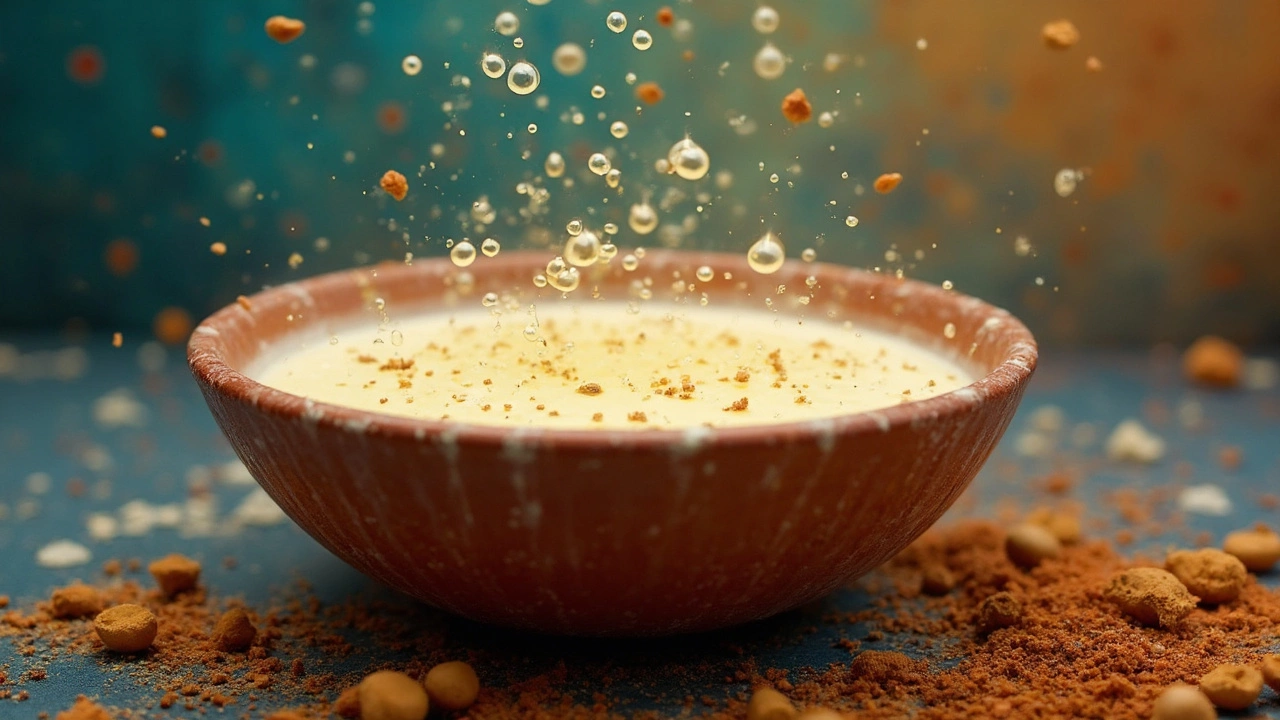Quickly Making Dosa Batter Rise Without Yeast: Your Go-To Guide
 Feb, 18 2025
Feb, 18 2025
Ever wonder how you can skip the yeast yet still get your dosa batter to rise quickly? You're not alone! Many home cooks are on the lookout for shortcuts to make that perfect dosa without the overnight wait. Lucky for you, the secret lies mostly in the technique and a little bit in environmental conditions.
First off, the ingredients matter a lot. Using fresh urad dal and rice can make a significant difference. The freshness usually impacts the fermentation process, both in flavor and in the way the batter rises.
Next, let’s talk soaking times—for the dal and rice to break down properly and start fermenting at a good pace, they should be soaked for the right amount of time. Generally, the rule of thumb is 4-6 hours, but a slightly longer soak in cold weather can be beneficial.
- Understanding Ingredients
- Optimal Soaking Times
- Temperature and Environment Hacks
- Blending Techniques
- Immediate Fixes for Quick Fermentation
Understanding Ingredients
Making the perfect dosa starts with getting the dosa batter just right. And that means knowing a bit about what goes into it. The key ingredients typically are rice and urad dal, and their quality really impacts how well your batter will ferment and rise.
Choosing the Right Rice
Not all rice is created equal when it comes to making a quick-rising batter. Most recipes call for a type of parboiled or idli rice. These types have been shown to produce better fermentation results compared to regular varieties. Plus, their starchy content can make your dosas crispier.
Freshness of Urad Dal
Urad dal is another hero when it comes to fermentation. Fresh dal can ferment more efficiently, helping the batter to rise without the need for yeast. Always check the packaging date if you're buying from a store or go for places that have quick turnover in stocks.
The Magic of Fenugreek Seeds
Here’s a tip you might not have known: adding a touch of fenugreek seeds to your batter can do wonders. They not only add a hint of subtle flavor but significantly help in the rising process as well.
Proportions That Work
Getting the right proportion is often the first step toward success. A common and reliable ratio is often 3 parts rice to 1 part urad dal. A sprinkle of fenugreek seeds, say a teaspoon per cup of dal, can round it off nicely. These proportions tend to allow optimal fermentation.
| Ingredient | Recommended Amount |
|---|---|
| Rice | 3 cups |
| Urad Dal | 1 cup |
| Fenugreek Seeds | 1 tsp |
Now that you know what it takes to have your ingredients in top shape, you'll see a less time-consuming rise in your dosa batter. It's all about working with what you've got and making sure those basics are covered!
Optimal Soaking Times
Getting your dosa batter to rise without relying on yeast hinges a lot on how well you soak your ingredients. Soaking is the first step to breaking down the rice and urad dal, setting the stage for perfect fermentation.
Ideally, you should soak both rice and urad dal separately. Rice typically needs a bit more time, so soaking it for about 6-8 hours can really make a difference. The dal will usually be good to go in 4-6 hours. But, here's a tip—if it’s a chilly day, you might want to add an extra hour or two to give them both a little more time.
Why Separate Soaking?
Let’s get into why soaking separately matters. Rice needs more time because it’s tougher and benefits from a longer soak to soften up. Urad dal, being softer, breaks down quicker, creating that essential frothiness when blended.
This separates their optimal soaking times and helps in achieving the right texture when you eventually grind them together. Remember, the magic is in how you combine them later on.
Tips for Quick Fermentation
- Use warm water for soaking to jumpstart the breakdown process. It's like giving the grains a cozy bath!
- Add a fenugreek seed or two. A little trick that not only helps with fermentation but also adds a slight punch of flavor.
- If soaking during cold weather, a dash of salt towards the end of soaking can help keep things moving along.
The goal is to get that soft, slightly airy texture in both the rice and dal before you even start grinding. Trust me, getting the soaking times right makes all the difference for quicker rising dosa batter without any yeast.

Temperature and Environment Hacks
One of the key factors in getting your dosa batter to rise quickly without yeast is managing the temperature and environment. Let's uncover some easy hacks!
Warm Storage Location
Find a cozy spot in your kitchen. If your kitchen tends to be on the cooler side, try placing the bowl of batter in the oven with just the light on—no heat. This small hack provides just the right amount of warmth needed for fermentation.
Use Warm Water
When grinding your rice and urad dal, try using warm water instead of cold. This little twist can kickstart the fermentation process, making it more effective in a shorter time.
Invest in a Yogurt Maker
If you're into gadgets, a yogurt maker is a smart buy. It keeps the batter consistently warm, providing an environment similar to South Indian weather — ideal for your dosa batter to rise perfectly.
Cover with a Cloth
While most cover their batter with a lid, using a thin cloth instead can allow the batter to breathe and ferment better. The slight exposure to air can often speed up the rising process.
Playing around with these temperature tricks can turn out to be a game-changer. A bit of experimentation with any of these tips will let you nail that perfectly risen, fluffy batter in no time!
Blending Techniques
Okay, let’s talk blending techniques, because getting it right can make all the difference in your dosa batter success. After soaking the rice and urad dal adequately, you’ll want to grind them into a smooth paste. But, did you know the sequence and the way you blend them can impact the batter's rise?
Get the Grinding Order Right
Start with soaking and grinding the urad dal first until it's smooth and fluffy. This fluffiness is your ticket to a well-fermented batter because air incorporated helps with better fermentation. After you get that fluff, move on to the rice. Blend it until it's really smooth.
Blender vs. Wet Grinder
If you’ve got a wet grinder at home, that’s your best bet. They’re known for grinding ingredients to the ideal consistency without overheating. However, if all you’ve got is a regular blender, don’t worry. Just blend in short bursts to prevent the heat, and add cold water if necessary to keep it cool.
Temperature Control
Heat can be a real problem as it can impede fermentation. It might sound weird, but warm batter doesn’t rise as well. So, having a cooled blending process can help ensure a quality rise without the need for yeast.
A Quick Blending Tip
- Use ice-cold water when blending—this keeps the batter cool and the fermentation process more efficient.
- If you’re using a high-speed blender, blend in stages with pauses in between to keep things cool.
- After blending, you'll notice the batter is still warm; ensure you cool it down to room temperature before storing it for fermentation.
There you have it, a few simple steps that make a massive difference in getting your dosa batter to rise quickly. Just a smooth, non-heated batter thanks to these blending techniques can be your secret weapon in the kitchen!

Immediate Fixes for Quick Fermentation
Let’s be honest. No one wants to wait forever for the dosa batter to ferment. But, good news! There are some nifty tricks to speed up the process, even without using yeast.
Use of Fenugreek Seeds
Adding fenugreek seeds (methi) is an age-old trick that works wonders. Just a teaspoon while soaking the urad dal can significantly boost fermentation, thanks to its natural enzymes.
Warm Environment
Creating a warm environment can spur the fermentation process. Try placing your batter in an oven that’s pre-warmed (not hot!) or wrap the container in a thick blanket. This helps maintain an even temperature around the batter.
Avoid Metal Containers
Metal containers aren't the best friends of quick fermentation. Instead, opt for ceramic or glass bowls which allow the batter to breathe better, facilitating a faster rise.
Adding Salt at the Right Time
Timing salt addition can be a game changer. Sprinkle it right before setting the batter for fermentation. If you’re in a real hurry, a pinch of sugar might also help kickstart the process.
Using Fermented Batter from a Previous Batch
If you've got a leftover from your last batch, toss a couple of tablespoons into the new batter. This acts like a natural starter and accelerates the fermentation.
Keep these tips in your back pocket, and you’ll be rustling up fluffy dosas without the all-night wait. Fast-track your dosa batter and never look back!